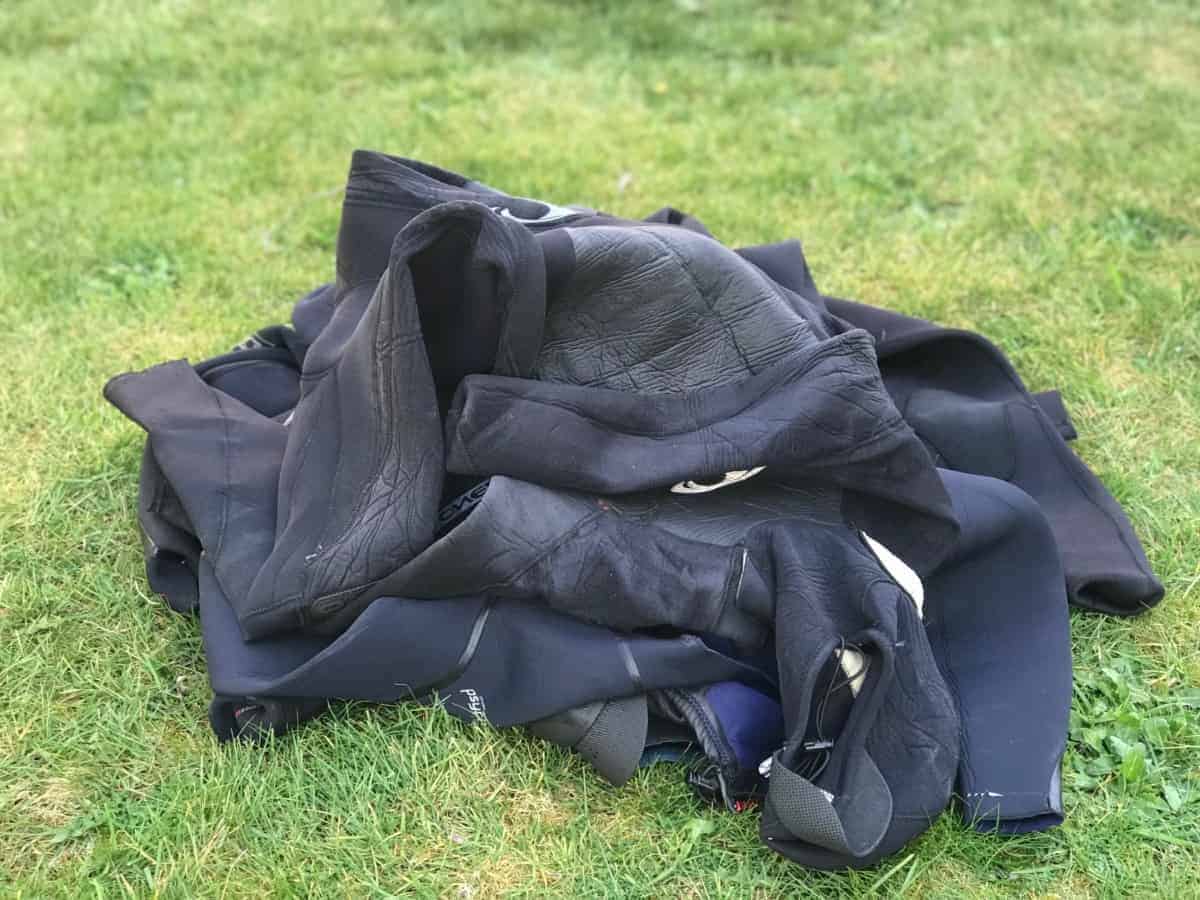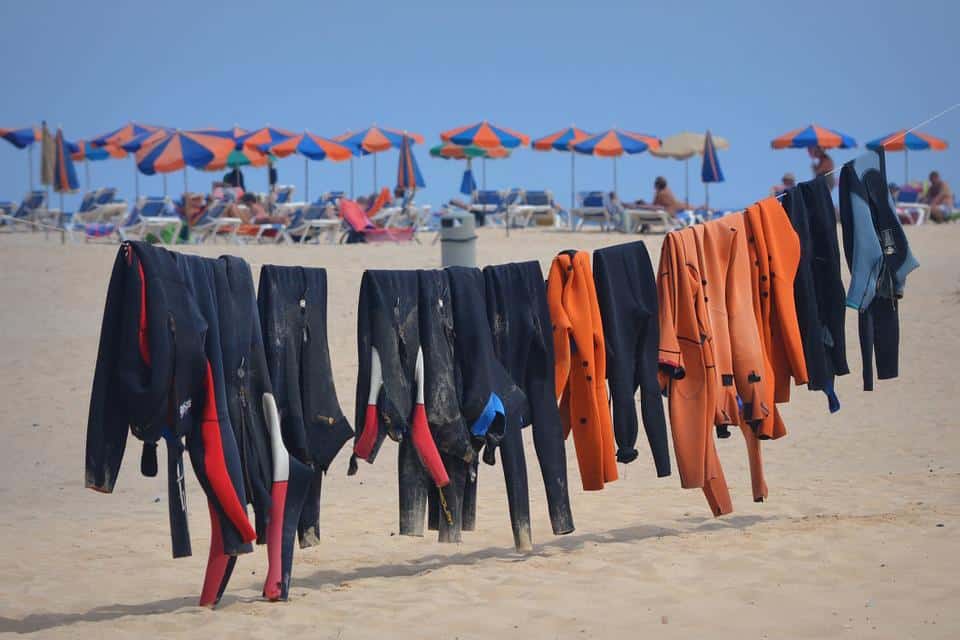Wetsuits are incredibly beneficial to have in many situations in the water, and most surfers own one or a few. The good news is that it is not too common for a wetsuit to shrink if given the proper care.
So, Do Wetsuits Shrink Over Time?
Wetsuits do shrink over time; however, it takes many years. Neoprene has layers made of thousands of cells filled with insulating nitrogen, which keeps a thin layer of water warmed by body heat. Heat or extreme pressure will expand these cells, causing the air cells to collapse, causing the material to shrink.
Although it takes many years for a wetsuit to shrink with use naturally, other factors can speed up the process deteriorating suits much sooner. Quality of care and material of a wetsuit also plays a crucial role in determining how long the suit will last.
Wetsuits And Shrinkage
Many people think their wetsuit has shrunk after not using it for a season, but it is most likely the person has expanded their size or weight. A wetsuit will not shrink that quickly; it takes several years for the material to deteriorate.
Most wetsuits do lose their elasticity, creating a shrinkage effect that is caused by the cells of the neoprene deflating in a sense. The sun, minerals in the water, stretching to get into the suit, proper or improper care of the suit, and general abrasion all contribute to the wear and tear of a wetsuit.
Spending several seasons in the sun causes neoprene to age, which makes the air cells in the material to collapse. Aging of the material causes the suit to become stiffer and uncomfortable to wear.
Luckily, with proper care, a good quality wetsuit can last several years. Many people make the mistake of buying low-quality suits and practicing improper care, causing them to have to buy another suit sooner than necessary.
How Long Does A Wetsuit Last?
A well-made wetsuit should last anywhere from four to ten years, provided it comes from a quality manufacturer. A wetsuit will not last an entire lifetime but will last several years, given the right circumstances. It is better to spend a little more money initially rather than more money later on.
Cheaper brands of wetsuits that are made of lower quality material and have more mediocre construction quality might only last a season or two. Zippers and other malfunctions usually become a problem before shrinkage does in these suits, but reduction does happen significantly sooner than others made of quality construction and materials.
How long a suit will last depends heavily on how often you use it and the quality of care you give it. The conditions the suit is used in, the type of water and aftercare, and timely repairs all factor into how long a wetsuit will last.
If a wetsuit is used continuously in a rough manner, this will cause zippers or velcro to ruin beyond repair, no matter the quality of the suit. A tear on a wetsuit that isn’t repaired quickly will become a more massive tear, which can ruin the suit beyond repair.
Chlorine in pools accelerates the aging process of a wetsuit causing it to become brittle and stiff over time. If a suit absolutely must be used in a chlorinated pool, thorough rinsing afterward is crucial to the quality of the suit. Repeatedly using a suit in a pool will, however, have adverse effects on the wetsuit, no matter how well it is rinsed each time.
Saltwater also compromises the neoprene, causing weakness that affects the lifespan of the suit. Wetsuits that are used in saltwater must be rinsed before they have a chance to dry to replace the neoprene cells with fresh water. A suit that is used often in saltwater will still need to be replaced sooner than a suit used in freshwater, no matter how well it is taken care of.
It is common for a wetsuit to be nicked and have small tears several times throughout its lifetime. Small tears not taken care of immediately will become larger tears and possibly need to be taken in for repairs or replaced. This can be costly.
Neoprene patches make it very simple to repair a small tear by its owner, without having to be taken in for repair or replaced. A neoprene patch is as simple as using a paintbrush, brushing the area, and waiting for it to dry.

How Should A Wetsuit Fit?
The suit needs to be super form-fitting; some experts use rash guards and layers of sunscreen to slide into tight suits. A tight suit is essential to staying warm in the water and needs to fit snugly. Proper fitting suits will be snug and not too tight or too loose.
A suit that is too loose will allow too much water into the suit, which will slow the surfer or anyone moving in the water significantly. While a suit should fit tightly, it should not be restrictive of movements or too uncomfortable.
Wetsuits that fit correctly will have no air pockets or creases in the neoprene. While trying on a wetsuit, it is advised to perform a few movements such as shoulder swings and front-crawl arm strokes checking to make sure the arms and chest can move freely.
Different variations in cell sizes and cell wall thickness give varying resistance to heat and pressure, being the reason there are several different types of wetsuits. Wetsuits differ depending on what their intended use, and even how cheap it is to make them.
Some wetsuits are made to be lighter and more stretchable because they are cheaper to produce. Many people buy them in the stores because these suits are more comfortable than the thicker and more durable suits. These more inexpensive suits are more likely to shrink, however. Professional grade diver suits are less likely to shrink because they are much more durable.
What Is Neoprene And What Does It Do?
Neoprene is a synthetic rubber made up of layers of small cells filled with air that traps a thin layer of water that is warmed by body heat. Thousands of tiny cells contain bubbles filled with insulating nitrogen. These gas bubbles can, over time, escape through the cell walls.
Exposure to heat, such as being in the sun over time or being put into a drying machine, will expand the bubbles causing some to rupture the cell walls. Repeatedly exposing the neoprene to pressure underwater will compress the bubbles and cause them to escape, which is why it is essential to use the proper suit when diving into deep depths.
How To Prolong A Wetsuits Life
To prevent shrinkage and to properly dry your suit, dry it in a dive locker or a dryer on very low temperatures. Do not dry the suit in direct sunlight; this will cause it to shrink over time. Sunlight will overheat the foam cells and also cause the fabric to fade, even a black wetsuit.
Always rinse your wetsuit in fresh, non-salt, and non-chlorine water after each use. When in saltwater rinse after each time you leave the water, even if you plan a second session. In the event you won’t be taking the suit off in between sessions, use a jug of warm water to pour over yourself and the suit. Remember to take the suit off and thoroughly rinse both the inside and the outside of the entire suit.
Hang your wetsuit inside out doubled over the bottom rung of a hanger in a shower or garage out of the sun. Do not drape it over objects, and do not hang it by the neck or the shoulders. Never, ever dry your suit in the sun! Remember to turn it right side out and give the other side a chance to dry too.
Using a wetsuit shampoo regularly can significantly improve the longevity of your suit. Even with daily washing, not everything can be collected and rinsed out. Washing your suit in a bucket full of cold water and wetsuit shampoo will thoroughly remove any lingering saltwater and anything else left behind.
Avoid using any petroleum-based lubricants because it can significantly break down the neoprene. Avoid using vaseline, baby oil, hair conditioner, and petroleum cosmetics as these can slowly eat away at your suit.
Store your wetsuit in a cool, dry place with temperatures below 75℉ away from direct sunlight and heat. To avoid the absorption of moisture, keep products wrapped or sealed.
Before your first use of the season, soak your suit in water and then hang it up to dry. Your suit will be dry to the touch, but some water will still be in the neoprene, which makes the suit more flexible and easy to get into.
Regardless of your water travels together with your suit, always care for your gear with kindness, and your gear will return the favor.


